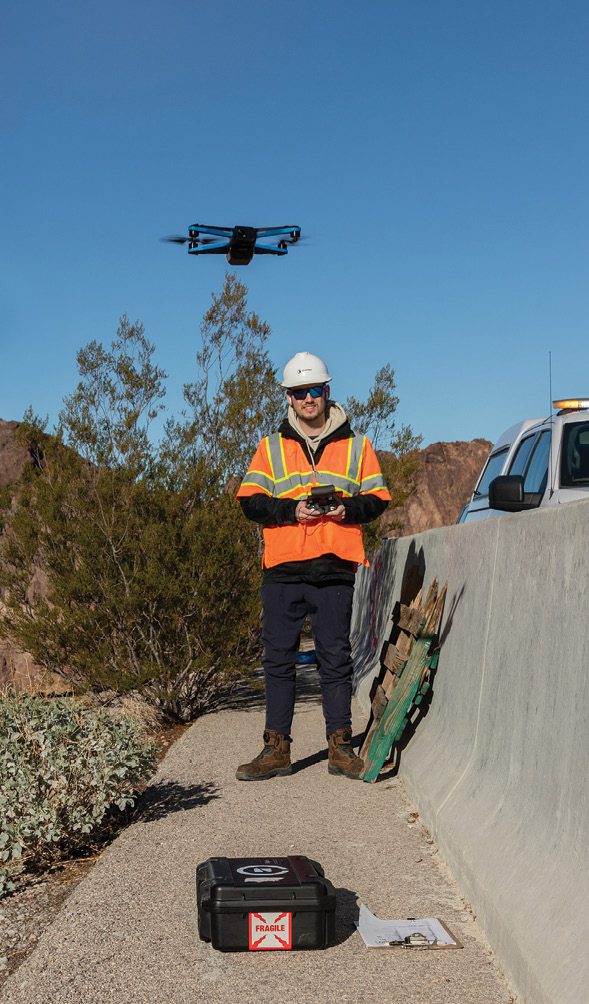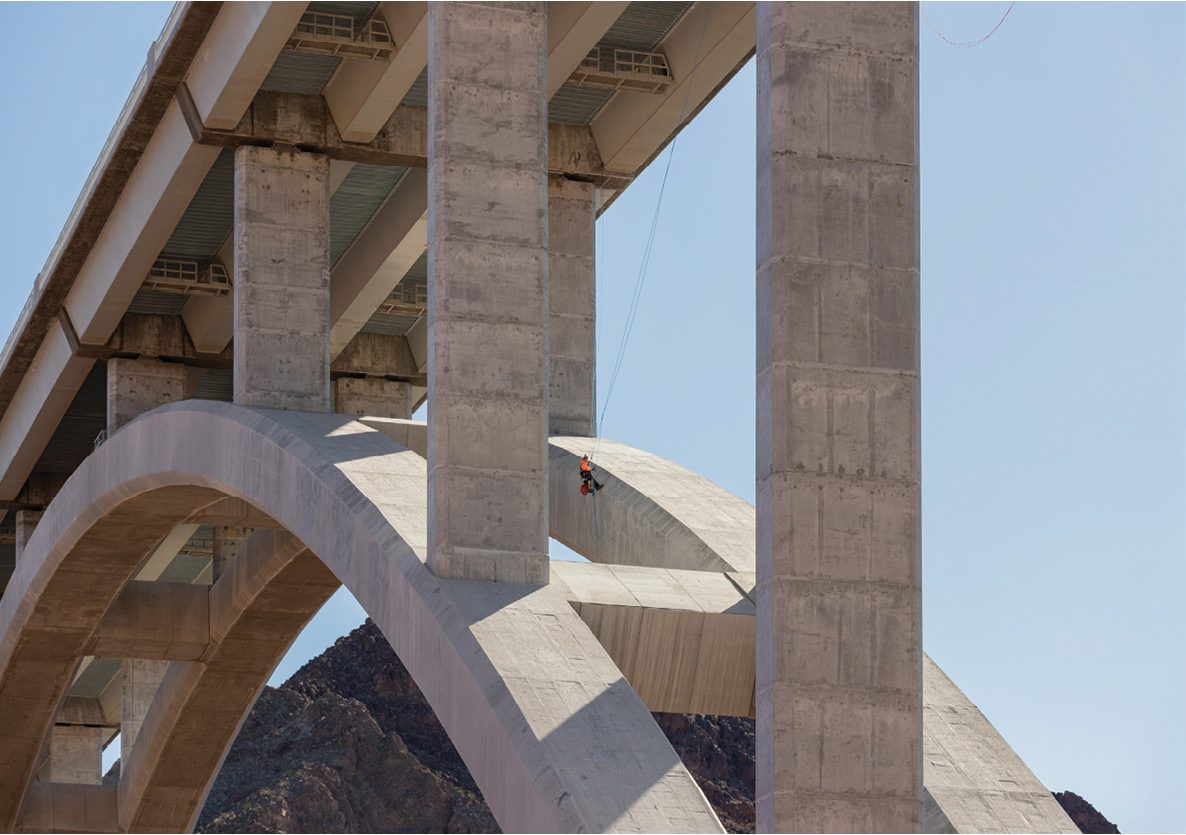Off Rope! Drones for Bridge Inspection Increase Safety, Decrease Costs
It requires a few things for a bridge engineer to become a rope-access technician and climb up and down the most-difficult and complicated bridges:
• No strong fear of heights. The photos in this article show that to be obvious.
• A lot of training. Any technician needs to become certified by the Society of Professional Rope Access Technicians (SPRAT). The highest level (Level Three) requires hundreds of hours of rope work as well as completing three training programs and exams.
• An interest in rock climbing. Some started climbing before or as they became engineers in college; others were engineers who later became interested in climbing.
Michael Marshall, a bridge inspection engineer and UAS bridge lead for Stantec, was one of the latter. Although more than half of his bridge-inspection team grew up rock climbing, it was something he learned to do on the job.
“I was not a recreational rock climber before I became a SPRAT technician,” he explains. “It was just something that was really interesting to me, especially when I got into the coursework.”
The Mike O’Callaghan–Pat Tillman Memorial Bridge is a very special bridge (see “Bridge Background” for details), and it requires the highest level of SPRAT engineers: a Level Three supervisor at all times.
“That Level Three is not on rope,” notes Marshall. “They’re up on the deck, and they’re coordinating and ensuring the safety of everyone else. And then there’s everything from Level Threes down to Twos and Ones all on rope at once.”
As much as these technicians love their jobs and the beauty and exhilaration of climbing, the amount of time they’ll be “on rope,” at least for their jobs, is rapidly diminishing. Drones are increasingly being used to lessen the amount of time needed to survey and inspect bridges, resulting in increased safety and decreased costs.
Disruptive Technology
Drones or Unmanned Aerial Vehicles (UAVs) no longer can be considered new technology—they’ve been around for decades. But recent advances in how they’re flown and the data they can collect are rapidly changing the bridge-inspection industry, which previously was solely based on roped engineers and specialized inspection trucks called “snoopers.”
Stantec has long been in charge of inspecting the O’Callaghan–Tillman Bridge, and Marshall has been part of many of its inspections. Drones had been used before, but he notes they previously didn’t realize much savings. The initial drones required advanced piloting, adding specialized personnel to the budget just to fly the drone. It also took a lot of time to create a visual model the engineers needed to see before they knew where they still must climb.
All this changed when Stantec partnered with Skydio, a technology company founded in 2014 that combines drones, sensors, artificial intelligence (AI) and sophisticated programming to enable its drones to fly autonomously without highly trained pilots.
The core technology is “Skydio Autonomy,” which utilizes six 4K navigation cameras—three on the top and three on the bottom—and a high-performance processor that work together to instantaneously create a 3D map of the surroundings, allowing the drone to understand its environment and make decisions in real time.
One of Skydio Autonomy’s key applications is the Obstacle Avoidance. “Think about it as a (protective) bubble that is surrounding the platform, the drone itself,” explains Alicia Llorens, principal solutions engineer for Skydio who worked closely with Stantec on the O’Callaghan–Tillman Bridge project. “The drone will always avoid obstacles, minimizing the risk of collision at all times. There are different settings for that obstacle avoidance, so you can reduce that protective bubble and navigate safely in confined spaces.”

Such ease of use is a major source of a project’s time and cost savings, as Skydio claims an operator can become proficient in flying one of its drones in less than an hour. Engineers such as Marshall and his team then become the pilots and observe the bridge live as the drone flies.
“When Skydio came along, a door opened for the bridge inspector to put on that pilot hat,” says Marshall. “Now the bridge engineer can do things even quicker than an advanced pilot could two or three or four years prior to that, just because of what’s built onto the drone.”
“We remove the stress of the operator, who oftentimes is someone like Michael, a bridge engineer, and we try to enable them to focus on the inspection vs. on the drone operation,” notes Llorens.
“The drone is flying itself, and I’m able to look at the screen and see what the drone is seeing,” Marshall adds. “I know that it’s getting the correct pictures and everything I need post-production, so I can focus more on what we are seeing in the model itself. I can be the inspector on the screen.”
After the drone has done its work, engineers can decide if they would like the drone to look again at a possible problem or send a rope team to look at specific areas.
The Savings
No technology, no matter how groundbreaking or innovative, is adopted unless it adds value to a project. At the O’Callaghan–Tillman Bridge, Stantec found value in the Skydio drones immediately and in a wide variety of areas.
Putting specialized climbers in dangerous positions less often is an obvious safety improvement; and cutting those manhours from the budget—in addition to travel and non-climbing engineers and support—is an obvious cost reduction, but Marshall notes there are less-obvious savings from completing the project in about half the time.
“By removing the need to repel every single approach column, it took away an entire week’s worth of work,” says Marshall. According to the Nevada DOT, the latest O’Callaghan–Tillman Bridge inspection, using the new drones, saved $40,000. “It’s not just the climbers for two weeks, it’s also everything that’s happening on the deck that folks aren’t seeing. The traffic-control personnel, the operators of the snooper trucks that were there, the officers that were onsite to maintain safety, all of those add up to hours,” adds Marshall.
A Better Model
Budgetary savings are important and easy to see on a spreadsheet, but Marshall believes an improved end product—the bridge inspection report—is at least as important.
A typical report to a bridge owner or client (such as a DOT) is black-and-white text with some associated photos. Sensors and cameras in drones help provide video and a complete 3D model that provides much more data and context to help make decisions.
According to Marshall, a 3D model shows owners a complete picture, not just with the bridge, but what’s happening around the bridge and what might be causing certain problems to help make better decisions and keep infrastructure upkeep at the highest levels.
“I always say ‘a picture’s worth a thousand words,’” he notes. “But to then take it to the next level and piece them together in terms of either a video or a 3D model, that picture’s now worth exponentially more.
“I can’t put everyone on a rope and show you exactly what I’m looking at while I’m on the bridge,” he adds. “But if I can spin you around [the model] and take you safely from your office into that world and show you exactly what I’m seeing without any text, without pictures, immerse you into it—it really puts the understanding throughout. We can explain ourselves a lot better.”
“Drones and drone data are yet another tool in the inspector’s toolbox,” adds Llorens. “It provides better information and better views in a matter of hours without the complexity and risk of traditional methodologies.”

A highly certified Stantec bridge engineer makes a breathtaking rope descent of the Mike O’Callaghan–Pat Tillman Memorial Bridge.
Will Machines Take Over?
Although Marshall and Llorens are major proponents of drone technology, both believe a human engineer remains key to the final decision-making process and will never be completely replaced by drones and AI technology.
“I would never say never, but it’s so critical to have an engineer onsite, see it firsthand, be able to touch the defects or touch the bridge, and see what’s going on with the bridge,” explains Marshall.
Llorens has been in the high-tech industry for 12 years and has seen amazing breakthroughs and development, but she believes it’s the humans who make technology smart.
“We can’t replace a human being and the judgment of an inspector making a decision whether ‘this is a crack or corrosion’ or things like that,” she says. “Machines will help optimize that workflow, but I don’t think they will replace the subject-matter experts.”
Video Vault
Another high-quality video showcasing the Skydio X2 model can be viewed from bit.ly/3PaBYkm.
The complete video interview from which much of this article is based can be watched at bit.ly/481hoLX.
Bridge Background
The Mike O’Callaghan–Pat Tillman Memorial Bridge is one of the most-famous and chronicled U.S. bridges built since the turn of the last century. Although the main article is about adding drone use to bridge inspection, the bridge itself is a marvel and deserves additional attention we don’t have space for in this magazine.
Bridge construction began in 2005 and was completed in 2010 to reroute US 93 from a dangerous and inadequate route directly across the Hoover Dam, which was built between 1931 to 1936 and is also one of the world’s engineering and infrastructure marvels. Crossing the Colorado River between Arizona and Nevada, the bridge was jointly named for Mike O’Callaghan, governor of Nevada from 1971 to 1979; and Pat Tillman, an American football player who left his career with the Arizona Cardinals to enlist in the U.S. Army and was killed in Afghanistan in 2004 by friendly fire.
The bridge was the first concrete-steel composite deck arch bridge built in the United States and incorporates the widest concrete arch in the Western Hemisphere. At 890 feet (270 meters) above the Colorado River, it’s the second-highest bridge in the United States.
Besides these facts gleaned from Wikipedia, there are countless photographs and written accounts of this bridge. I highly recommend watching a 12-minute video made by T.Y. Lin International, which helped design the bridge. It features Jamey Stillings, a renowned photographer, and some of his stunning images chronicling the bridge construction; and David Goodyear, T.Y. Lin International lead design engineer. Watch the video at the top of this post or at bit.ly/3r0P3Vy.
As for those involved in the bridge inspection featured in this article, the following are some of their thoughts on this iconic bridge:
“It’s a different beast in its own regard. It’s not just high up there, but it’s a different type of construction that we’re not used to seeing. It’s just monumental in terms of what you’re seeing with the Hoover Dam in the background and then the Colorado River on the other side. It’s something that you don’t get to see every day as a bridge inspector.”
— Michael Marshall, Bridge Inspection Engineer, UAS Bridge Lead, Stantec
“It was one of the largest infrastructure projects I’ve done yet in my professional career. The level of stress and different environmental factors they need to deal with throughout that inspection process is just incredible.”
— Alicia Llorens, Principal Solutions Engineer, Skydio
“It’s this beautiful Arch structure; it’s iconic to me. You have this major Gorge right in front of the Hoover Dam. There’s nothing like it.”
— Karen Bosworth, Civil Engineer/Bridge Inspector, Stantec

About Todd Danielson
Todd Danielson has been in trade technology media for more than 20 years, now the editorial director for V1 Media and all of its publications: Informed Infrastructure, Earth Imaging Journal, Sensors & Systems, Asian Surveying & Mapping, and the video news portal GeoSpatial Stream.


